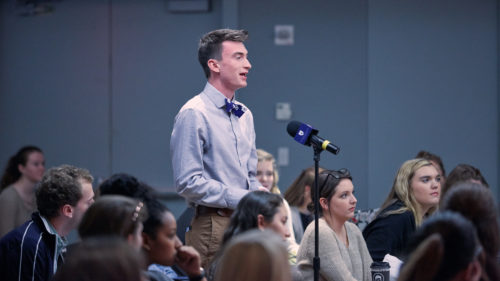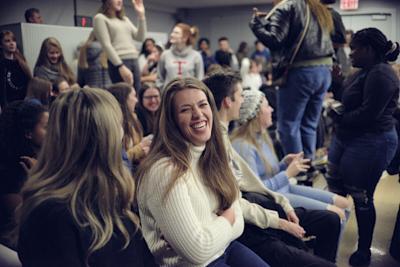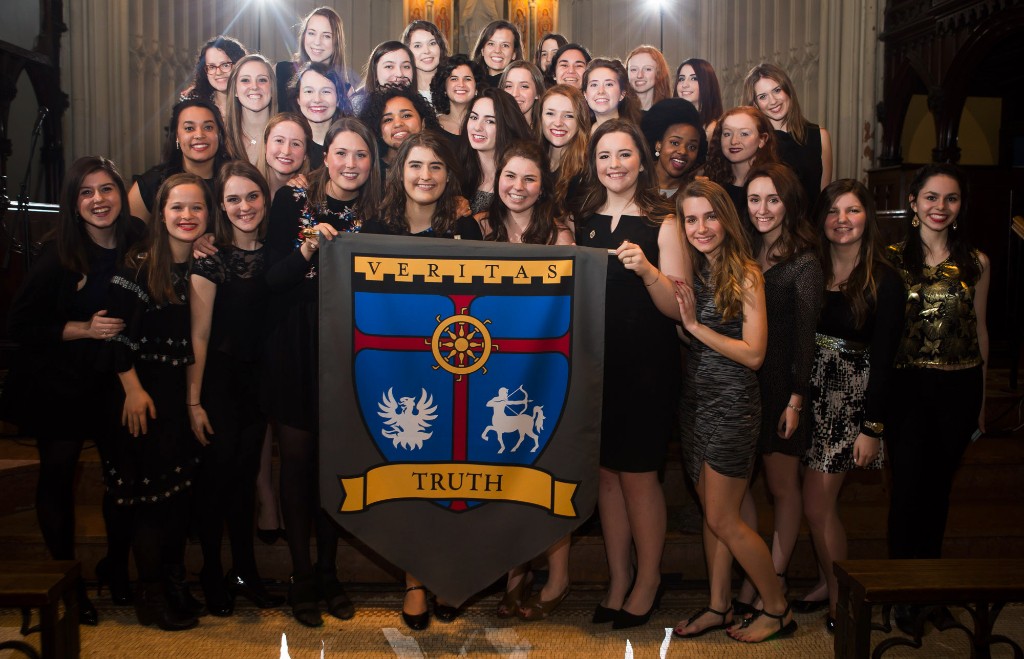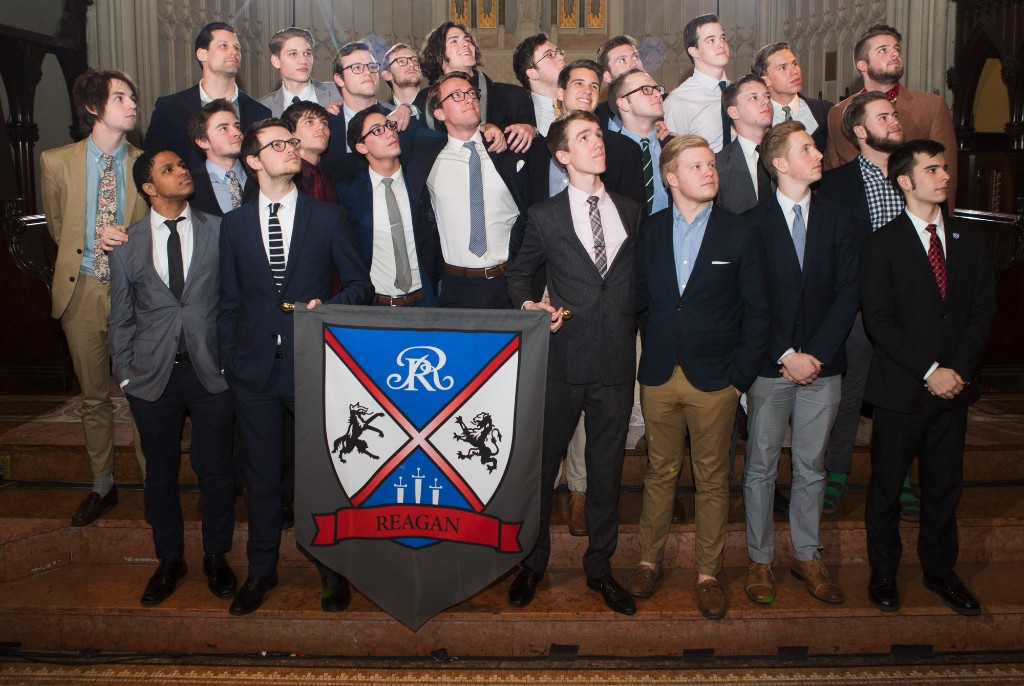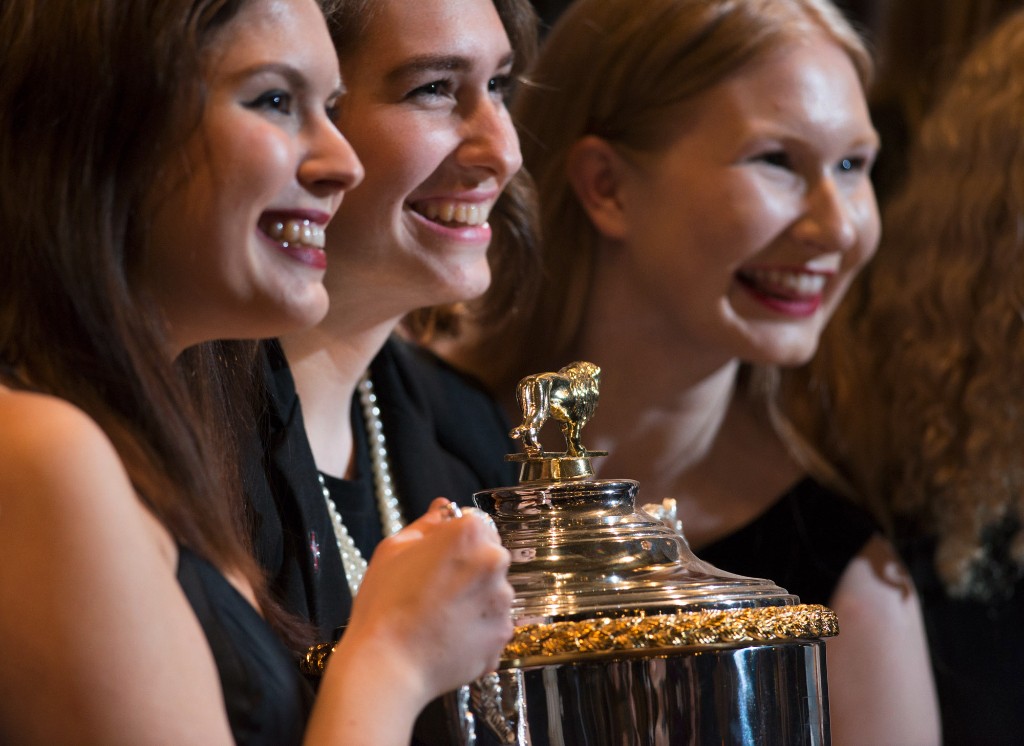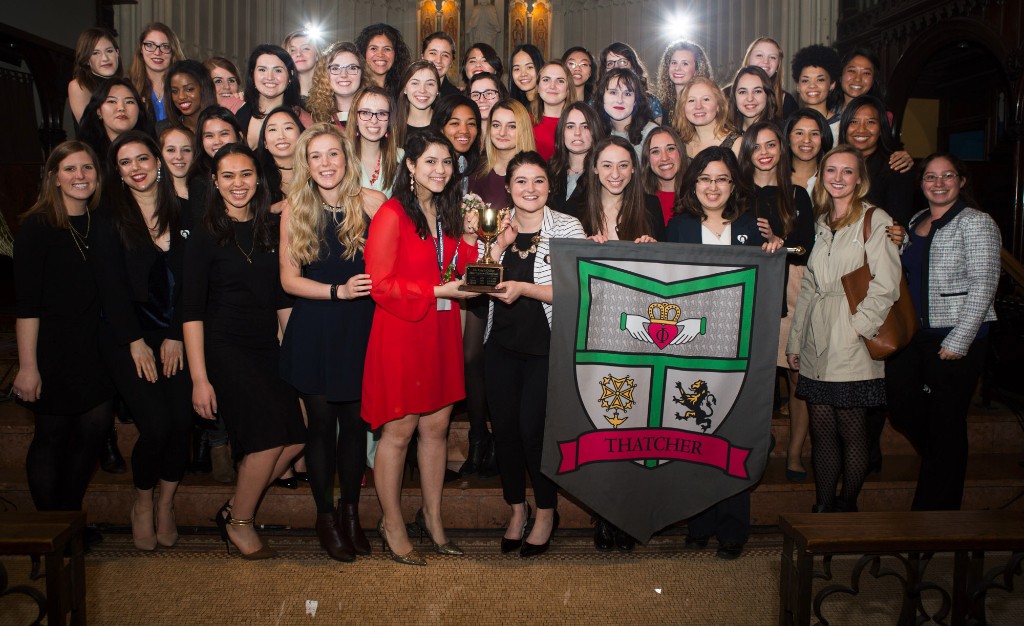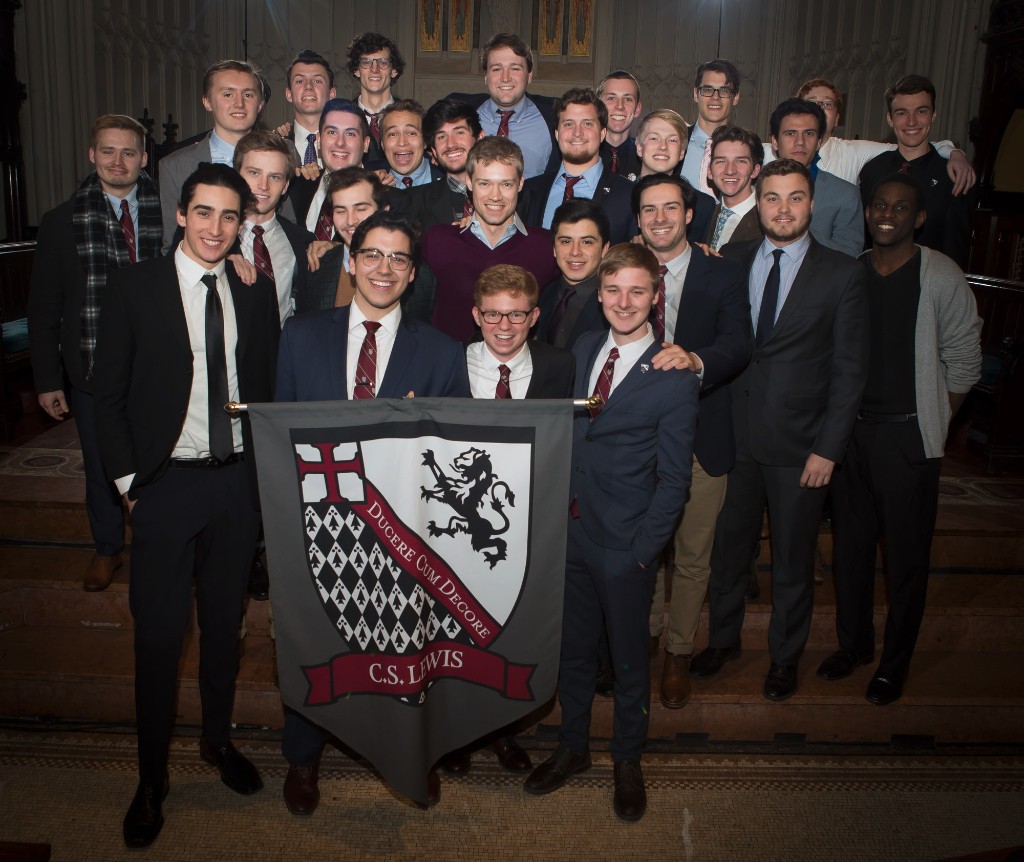Making Houses Home: The Story of the Peculiar Shape of Student Life at The King’s College
How did King’s come to have a house system, and how important has it been to the College? And what is a house system anyway?
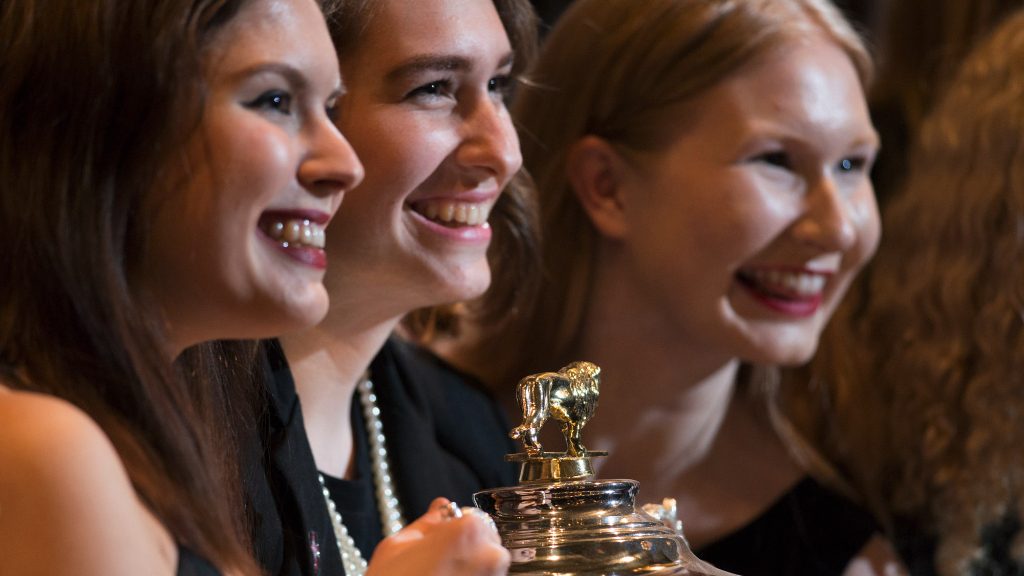
The House System at The King’s College is perhaps one of the less familiar features of life at King’s; it is also one of the most-trumpeted arrangements of student life during the admissions process and has been responsible for some of the most-loved memories of Manhattan alumni. How did King’s come to have a house system, and how important has it been to the College? And what is a house system anyway?
Houses developed in English boarding schools during the days of the British Empire. Collegiate Way, an organization that offers resources on developing house systems within larger institutions, says, “Readers who are new to this organizational model should understand that house systems and residential college systems need not be entirely, or even largely, residential, and they need not be curricular. The term house in these contexts, like the term college, does not designate a building or a curriculum, but rather a body of people . . . a network of member relationships, developed through long acquaintance in a stable community and regular interaction throughout the year.”[1]
The House System at King’s developed gradually, with many adaptations along the way as King’s sought to suit the model to its mission. David Leedy, now Dean of Students, came to King’s in 2000. The College was brand new and composed mostly of freshmen. It was also a commuter campus with an urban focus and a small variety of majors. It had only been open for a year, and in the way of student development, Leedy says, “There was really nothing. There were small groups here and there, one-on-one meetings, and some scattered events. My task was to figure out student life, spiritual formation, and so on . . . in a way that fulfilled the College’s mission.” While the curricular emphasis of King’s was not yet in its current form—focusing on the ideas and institutions that have shaped the West and built around the PPE core—it was a priority of Bill Bright’s from the time the College reopened that the mission emphasize cultural leadership. The present-day mission began to crystallize, and the PPE program was implemented, when Stan Oakes became the fourth president of King’s in 2003.
The House System launched in 2004-2005 as the main strategy to realize the College’s mission in student life. Elements of present-day traditions were in place as early as 2001, when freshmen were divided up into loose men’s and women’s small groups led by upperclassmen. They competed against each other in events that now feature in the all-school House Cup: the Great Race, a scavenger hunt based on clues that take students all over New York City; a drama competition; basketball; debate; and average House GPA.
In 2002-03, these groups began naming themselves. The Elohim Soldiers and Compassionate Hippos appealed mainly to the people who chose these names and not to anyone else who would come after. So, faculty and staff made a list, spanning “20 centuries and the globe,” of 67 real people who made a difference in history, as a better pool of group names.[2]
As the College got past its first few years, “it became apparent that a new strategy targeting the development of the entire community, not merely freshmen, was needed.”[3] Duanne Moeller, then Dean of Students, proposed modeling student development at King’s after the house model at Harvard. Houses at Harvard are large and elaborate, numbering 300-500 students. They are heavily structured around academics and residential in nature. Where student housing at many colleges and universities falls into the category of operating expenses or “necessary evils,” houses at Harvard are an essential, intentionally-designed part of the student experience. King’s wanted a house system that was similarly essential, but because of New York City real estate realities, a traditional residential setup was not initially financially viable.[4] The question was how to do it, and how to marry the model to the new mission of King’s.
The 2003-04 academic year was devoted to this question, involving hundreds of hours of research and discussion, including visits to Harvard and West Point.[5] Harvard’s houses, large as they are, are run by faculty and staff. Because King’s wanted to prepare students for leadership, the student development team[6] wanted to use the House system to give students leadership opportunities. Many members of Student Development knew the fraternity and sorority system from their college days, and knew that those organizations are independent of and often distract from the academic institutions where they operate. Yet they do offer a strong emphasis on student leadership. After studying student leadership development programs at 39 different universities, King’s blended the leadership model of the fraternity and sorority system with the academic house model, creating a hybrid system unique to King’s and its mission.[7] “The emerging model was one that would provide students with numerous opportunities for social life, spiritual nurture, and leadership growth, yet also support the academic life of The King’s College.”[8]
Putting it into practice came next. Upperclassmen were allowed to opt in to the new system; freshmen were assigned to Houses beginning in the fall of 2004. There were nine Houses, four men’s and five women’s, with two student leaders apiece.[9] Their first task was to name the Houses. The list of 67 historical namesakes had been narrowed to twenty. Selection criteria included that they be statesmen who changed society, that they be recognizable beyond Christian circles, and that their personal characteristics be worthy of imitation.[10] The student leaders’ final choices were Susan B. Anthony, Clara Barton, Dietrich Bonhoeffer, Winston Churchill, Queen Elizabeth I, C. S. Lewis, Ronald Reagan, Margaret Thatcher, and Sojourner Truth.
That year, the four-person team developing the House System[11] wrote its formal mission statement: “Through student-led, mission-driven communities, the House System equips students to shape the college today and society tomorrow.” Each House developed its own particular mission statement as well.
The Freshman Competition became the House Competition (also known as the House Cup), and, by Leedy’s account, the entire community lit up with a competitive enthusiasm previously unseen at the Manhattan campus. The first Interregnum was organized in the fall of 2004, providing a new outlet for this competitive spirit. Interregnum did not become part of the House Cup until 2007-08; but debate, which had been a student competition prior to Interregnum and around which Interregnum revolved heavily, was counted toward the House Cup by itself. City Engagement service projects also began that year, also initially part of the House Competition.[12] These projects included a subway marathon raising money to send high school students to an evangelistic winter camp and career development assistance for women coming out of abusive situations. The House of Clara Barton won the House Competition that first year.
Almost immediately, Leedy writes, it was evident that having two undifferentiated student leadership positions per House would overburden the student leaders and fall short of meeting the Houses’ needs as they grew. So 2004-05 was devoted not only to the first year of House life but to designing a new leadership structure. This was ready for implementation by late spring 2005: a five-member leadership team for each House, including a President, a Helmsman to welcome and acclimatize new House members, a Chamberlain to foster a community of honor and help students build healthy living environments, a Scholar who would coordinate academic support and cultivate intellectual life, and a Vicar to foster spiritual life. Each House was also assigned a Student Development staff member and a faculty member as advisors. The new structure was launched at a freezing weekend retreat in April 2005, where student leaders reflected on how they would build the House system into something that would, in turn, build the King’s community.[13]
This structure has mostly held up over time. Faculty and staff advisor roles have differentiated from each other more clearly, with staff advisors coaching students in their roles and faculty advisors developing their Houses’ intellectual depth and promoting opportunities for learning. The Vicar role was dropped at the end of 2006-07 because the role was ineffective and spiritual formation needed to be undertaken more seriously than a few students could offer and, in part, because it was felt that the whole community should be invested in spiritual growth. Around five years later, as the Houses surpassed 40 members, the core leadership of several Houses began to mark out junior leadership positions to support their own roles. All Houses have such “associate” positions in place now.
Some changes went beyond structure. In 2006-07, in the same swoop that leveled the Vicar role, the College’s CFO Gary Latainer observed that the student leadership culture was “too much like Sunday school” and not the kind of training that would prepare students for influential careers after graduation. In response, Student Development introduced minimum GPA requirements for student leaders, moved leadership retreats from secluded Bible camps to the Glen Cove Mansion on Long Island, extended the business casual dress code to include these retreats, and launched a leadership development initiative for student leaders. Eric Bennett, then Dean of Students, christened this initiative the Statesmanship Institute. The Institute originally focused on providing student leaders exclusive access to speakers who gave talks addressing “big ideas,” but these talks did not yield practical help for running the Houses. Statesmanship Institute meetings now focus on training designed to help student leaders build their Houses more effectively.[14]
The first year of the new leadership structure, 2005-06, was also a year of building traditions. Notably, the Houses designed their crests, which hang on banners along an entrance hall at King’s. But this year also contained significant trials. Leedy recalls, “The College faced a retention crisis due to rapidly rising academic standards. Many students, especially among the freshmen, were struggling to make passing grades in their courses. A spirit of negativity and murmuring plagued the community, with many students making plans to withdraw. This placed enormous strain upon House leaders, as they worked earnestly to retain members of their Houses. Struggling students were, unfortunately, concentrated in certain Houses; the survival of these Houses, especially that of Thatcher and QE1, was threatened.[15] Thanks to persistent leadership, bolstered by support from leaders in other Houses, every House weathered the storm.”[16]
Despite such setbacks, the Houses quickly became central, edging out the influence of the existing student government structure, which relied on class representatives. Leedy writes, “A weakness in the original House System model was thus revealed; there was no structure that allowed for House collaboration on issues of common concern.” In 2007, Bennett, working with student government president Ted Pantone (’08) and Kiley Humphries (’08), proposed that the House System and student government be joined together, with House presidents serving as voting members of the The King’s Council.[17] In April of that year, after numerous meetings in which students discussed merits and concerns, students voted to merge student government with the House system, and the nine House Presidents became representatives on the Council, presided over by the new student body president, Kiley Humphries. This Council assumed responsibility for extracurricular student organizations and their budgets, as well as the budget for the Houses, which Student Development had previously managed. Welding the Houses to student government strengthened both institutions and increased students’ influence overall.
The ideal size of Houses has been a subject of continual discussion since they began. Early students thought that if the Houses grew too large, the tight-knit sense of community would disappear. Intimacy among everyone, however, was never the goal. “We built them to grow to 100,” Leedy says, so the House System can double in size without straining its design. He agrees that the tone of community has changed: not all members of a House can be best buddies anymore. More often, a core group of deeply involved students centers the House and creates room for others to be known and have a place to belong. House ideals and the sense of common purpose remain strong, as does House loyalty. Leedy cited a survey about the Honor Code that the Office of Student Life conducts every two years, revealing that forty percent of King’s students have confronted other students about honor-related issues. Leedy says the only reason King’s enjoys such a high level of student investment in the Honor Code, despite its demanding requirement that students confront one another over issues of honor instead of just ratting each other out, is that the House system creates an environment of belonging that encourages students to take honor and the King’s mission seriously.[18]
Although the Houses have never approached 100, a new House for women was organized in 2009-10. Since more women than men attend King’s—as is true at colleges across the country—the women’s Houses were growing more quickly, making the House sizes potentially lopsided. In the spring of 2010, sixteen women committed to becoming charter members of a new House and met regularly to lay its foundations. After a year of extensive research and discussion, they narrowed their namesake options to Abigail Adams, the wife of President John Adams, and Corrie ten Boom, the Dutch Holocaust survivor who was arrested for harboring Jews and later spoke throughout the world about forgiveness. They ultimately chose Corrie ten Boom and welcomed their first freshman class in 2010-2011.
Building a house system, especially one as custom as the one at King’s, is not a small or casual task, but it has been worth the effort. Leedy writes, “More than any other student life initiative, the House System has fundamentally shaped The King’s College experience.”[19] He also says that from the beginning, the team at King’s was interested in creating something that might be useful to other institutions, though with the caution that building a House System, especially in established colleges and universities, is not to be undertaken lightly. This effort too is bearing fruit: a number of other schools have come to King’s over the years to learn about the House System, and that interest is only increasing. A growing number of Christian colleges, seeking to harness the power of community to enrich the student experience and accomplish their mission, are taking a serious look at houses.[20] It is too early to say whether King’s might lead any kind of movement toward a new model of student life and leadership in Christian schools, but it is not too early to say that the House System at King’s is doing just what it set out to do: preparing students for leadership and upholding what it means to be Kingsian, while offering community and belonging that help students flourish emotionally and spiritually in what is often the strange new world of New York City.
Did we miss something? All questions, comments, memories, and notes about additional facts or resources should be directed to The King’s College Historian Emily Schatz.
Eric Bennett, David Leedy, and Rebecca Au-Mullaney contributed to this article.
[1] http://collegiateway.org/house-system/, accessed June 4, 2018. Italics original.
[2] Leedy, David. “History of The King’s College House System.” Unpublished document provided in correspondence April 19, 2017.
[3] Leedy, “History of The King’s College House System.”
[4] Today, part of the College’s long-term vision of the House System is to eventually acquire residential space for each House, which could be enjoyed by both residential and off-campus House members.
[5] Leedy, “History.” Leedy mentioned in a phone conversation that the West Point visit took place first and focused on leadership development as well as, secondarily, the idea of an honor system—another core element of student life at King’s.
[6] The members of this team were Duanne Moeller, Eric Bennett, David and Kathy Leedy, Sharita Hunt, Dale Scully, Alcilia (Cielo) Delgado, and Sharon Nolt.
[7] Office of Student Development, “Leadership Development Programs: A Benchmark Study of 39 U.S. Schools Providing Leadership Development Services to Students.” Fall 2004.
[8] Leedy, “History.”
[9] Leedy noted that in a college as small as King’s was at the time, finding eighteen students qualified to lead was no small task—but eighteen upperclassmen committed to start the House system.
[10] It was not required that all namesakes be Christians, but it was required that Christians be able to find something admirable in them.
[11] The members of this team were David Leedy (then Director of Student Life), Cyd Kumi (Assistant Director of Student Life), Chris Pasquale (Special Projects Assistant for Student Life and Founding President of Churchill), and Jill Donnelly ’07 (Administrative Assistant for Student Life and Founding President of Barton).
[12] City Engagement was later removed from the House Competition and is now a joint venture between the Houses and the office of Student Life, in which Houses partner with specific nonprofits on a dedicated, long-term basis.
[13] At one point, each leader was given a brick. Each wrote his House name on one side of a brick and, on the other, a word to describe how he would build into his role—a tradition that has become a highlight of student leadership retreats ever since, resulting in a wall of bricks now installed in the café area known as the Fishbowl at 56 Broadway.
[14] In 2007-08, the office of Academic Affairs launched a “Distinguished Visitor Series” that brought high-caliber speakers for the benefit of the whole campus. Despite at least eight relevant, major, executive-level changes in the College’s administration since then, some version of this program has persisted to the present day (it is now called the Presidential Lecture Series) and the “great guest speakers for all” approach seems to be here to stay.
[15] One of the conditions placed upon Houses in the student handbook is that its collective GPA not fall below 2.5. If it does, the House is placed in a probationary standing, and if the House continually fails to improve it can be disbanded. There are, Leedy said, provisions in place to help Houses work through this probation and avoid being disbanded, and mentioned thankfully that the College has never actually had to use these measures. However, several Houses have come close enough to that low mark, or encountered other communal difficulties, that they have triggered concern and closer oversight.
[16] Leedy, “History.”
[17] Personal communication with Eric Bennett, June 4, 2018.
[18] Phone interview with David Leedy, May 18, 2017.
[19] Leedy, “History.”
[20] Phone interview with David Leedy, May 18, 2017.



